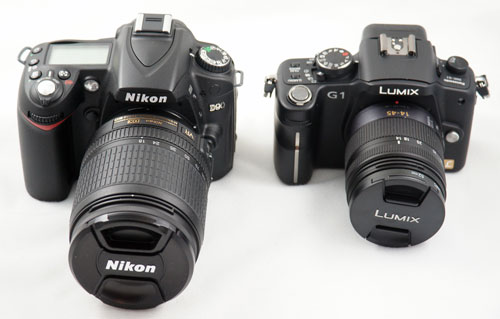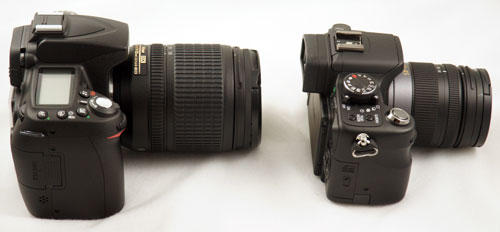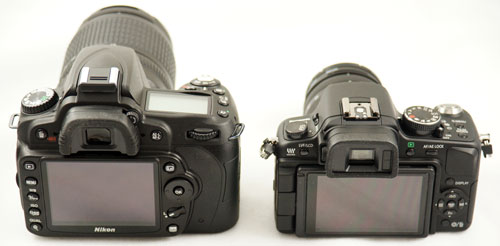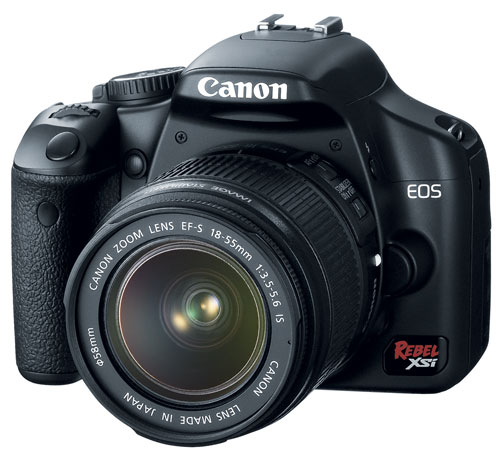Digital Cameras for the Holidays
by Wesley Fink on November 27, 2008 12:00 AM EST- Posted in
- Digital Camera
Entry Interchangeable Lens
Why should you spend more money for a DSLR than a point-and-shoot camera, when resolutions appear similar and the point-and-shoots offer the same features? It's all about the sensor and flexibility. The senor is an analogue device that converts light to a digital signal, so the larger the light gathering points (pixels) the more the ability to gather light and distinguish fine detail. The DSLR sensor is at least ten times larger than the typical P&S, so it can gather more light and resolve finer variations in that light. This means the image quality will be better with a DSLR and the sensor is capable of providing good images over a much wider range of light conditions than a P&S.
This category also features interchangeable lenses so you can choose to mount a wide variety of lenses designed for certain purposes - fast speed for low light, fast telephotos for sports, long telephotos for bird-watching, super wide-angle for sweeping landscapes, etc. The category name had to be changed this year to make way for a brand new category of digital camera. The Panasonic G1 is the first, but likely just the beginning, of the interchangeable lens digital camera without a mirror-box. That means it is not an SLR, but it does compete in the DSLR market space.

A Panasonic G1 recently landed in the lab, and we are mightily impressed. The descriptions of this little mirrorless interchangeable lens digital camera intrigued us, as they did everyone, but in the flesh the G1 is even more revolutionary and impressive.



You can see how small the G1 really is side-by-side with the new Nikon D90. There is the potential for micro 4/3 to go even smaller. The tiny 14-45mm zoom (28-90mm equivalent) really sets the size standard around which the 4/3 system will be built. What the pictures can't show is that while the G1 is small it does not feel cheap or too tiny in the hands. Ergonomics are very good, and the rubberized covering of the body will be loved by most and hated by a few.
The 23-point contrast detect AF is remarkably fast, so you can forget about Live View AF as a limitation - because it is fast on the G1, as fast as an optical DSLR with good phase-detect focusing. The view on the flexible 3" tilt-and-swivel LCD is very bright and clear, and as big as it gets in this class. The detail, with a 420,000 pixel screen, is better than anything else in its category.
The viewfinder is also electronic, but it's not like any of the limited EVF finders we have seen in the past. In most situations you have to remind yourself that this is an EVF, since the view is bigger and brighter than the normal DSLR with a pentamirror. It only gives itself away in very low light where the EVF becomes gritty and tears, but otherwise it is not a handicap at all.
There's lots of good news with the G1, but there is also the price. After using a G1, I understand the pricing at $795 - because it can easily compete in the prosumer class and $795 is a bargain in that space. However, that is not where the G1 will compete. It will be trying to grab market share from entry DSLRs where a $500 price is more appropriate. Fortunately, we already see dealers on eBay selling the G1 kit for $649 to $695. Special promotions like Microsoft Live Search cashback can reduce the price another 25%, getting the eBay final cost down to around $500, where the G1 is an incredible value.
The G1 by itself is good enough to compete in the prosumer market, and that says a lot. However, the micro 4/3 lens system is not here yet. Until there are more choices in micro 4/3 lenses and more 4/3 lenses that work completely on micro 4/3, the system can only be viewed as entry. The potential is certainly there, and as it is the G1 is an easy choice as an entry camera recommendation. You will see more about the G1 in an upcoming review.

In looking at a traditional DSLR in the entry class, the first consideration has to be value. As you saw in Sony A200: Entry DSLR Roundup, the Sony A200 stands out as a great value in a crowded field. The A200 inherits the sensor and electronics refinements of the A350/A300/A700 in a package that updates the A100, a camera originally designed to sell for twice the price of the $499 A200.
The 10.2MP A200 has faster AF than the A100, a larger 2.7" LCD, faster image processing, and more robust adjustment ranges. It also shares an optional battery grip with the A300/A350, correcting an omission on the A100. Neither the Nikon D60 or Olympus E420/E520 offer a battery grip option. The in-body image stabilization, is even more effective on the A200 and it works with any lens you can mount on the camera.
The Sony A200K, which includes the 18-70mm lens, is widely available for $499 or less. However, the 2-lens A200W is the real bargain right now with Sony instant rebates. You can get the two-lens kit, with the addition of the 75-300mm zoom, for around $549 at Amazon and other large etailers. The second lens normally adds $200 to the kit price.

You can never go wrong buying Canon or Nikon as your first serious camera, and it turns out the Canon XSi remains one of the best buys in the Canon line. The XSi price has dropped quite a bit since it was introduced and you can now find this superb 12.2MP camera for $650 or less with the Cannon 18-55mm IS (Image Stabilized) lens. Canon IS is in the lenses and not in the camera body, so you will need to buy IS lenses for that feature.

If every penny counts, as it does for many in these economic times, the 10MP Canon XS provides most of the XSi features in a cheaper package. The XS with the 18-55mm IS lens is selling for around $499, which is the same price as the Sony A200.
Both the XSi and XS feature Live View, which lets the user use the LCD to compose and focus pictures. This is a feature that is missing on the Sony A200. However, Live View focusing is very slow on most of today's DSLR cameras, with the exception of the Sony A300/A350, which feature Live View on a tilt LCD as their primary shooting mode. If Live View interests you, check out these two Sony models as well. The Panasonic G1 is also a Live View camera, but the fast 23-point Live View AF and flexible, accurate tilt-and swivel 3 inch LCD make it a no-compromise Live View solution.










41 Comments
View All Comments
gaston1 - Friday, November 28, 2008 - link
I totally agree about the Pentax part. How can one mention Canon 40d and 50d and totally miss to mention the 14.6 Megapixel K20D which is currently selling for less than $750 and is actually loaded with pro features!DragonzFx - Thursday, November 27, 2008 - link
I own a Fuji S100FS and for the price I paid ($720cdn tax incl). Thatis a lot of camera for the money in my opinion. It would have been nice to see this camera reviewed in your article as it is a great bridge camera. It is so feature rich and gives you the equivalent of a camera having anywhere from 35mm equivalent of 50mm Wide Angle all the way up to400mm Telephoto due to the 14x optical zoom. You can shoot fully manual or auto. In Jpeg or Raw, this camera does it all without the need to change a lense. And it uses a Li-on battery not AA's lol. Just my 2cents
Johnmcl7 - Thursday, November 27, 2008 - link
"If you are an Olympus fan, you will need to wait for a couple of months. Olympus has announced the new 12MP E30 that brings most of the great E1 features, including its super fast AF module, down to a lower prosumer price point."I assume you're referring to the E-3 rather than the E-1 and it's geriatric AF.
John
Wesley Fink - Thursday, November 27, 2008 - link
Yes, you correctly point out the E-3 is the Zippy AF master with 11 double-croos AF points (44 segments). I have corrected the typo.Dennis Travis - Thursday, November 27, 2008 - link
I just purchased the Canon A590 IS because I did not have a lot of $$$. It totally blows away my way more expensive Digi. It's an amazing little camera for the price and in spite of the price also. I took it to the opening of the Apple Store in my city and every picture was first rate and even though it was very crowded in there and I was in a hurry to get some shots, the IS did it's job. Not one bad pic in the lot and I took over 100.So many great features also with both aperture and Shutter Priority which is amazing at that price point. Canon did an excellent job with the A590 IS. I highly recommend it to anyone on a budget that wants a lot of control over your pictures.
brokensoul - Thursday, November 27, 2008 - link
No word of DxOMark ? new website, quite handy to judge pure Raw quality of sensors, but it could do with some explanations.. :-PNice work though, quite a broad coverage of the camera market
dani31 - Thursday, November 27, 2008 - link
Where is Panasonic DMC-LX3, probably the best compact in the world?zzzxtreme - Monday, December 1, 2008 - link
I agree, Panasonic DMC-LX3 is one of the best compact. It is what reviewers claim, almost like a $5000 Leica compact.Wesley Fink - Thursday, November 27, 2008 - link
We do agree the DMC-LX3 is a terrific Point-and-Shoot, but at $500 it is more than we can justify for a compact in today's market. As we stated in the review it is very hard to justify spending more than $250 to $300 in today's market with DSLR's starting at $400.The Panasonic G1 interchangeable lens large sensor - which was selected as the best entry large-sensor - is significantly better and more flexible than the LX3. With some selling it for $649 and special promotions getting the price below $500 in some cases the G1 is the camera we sould buy in this price class - or the Sony A200 2-lens kit or the Canon XS kit.
PrinceGaz - Thursday, November 27, 2008 - link
If you've got $500 to spend on a camera, and it's a choice between a quality compact you can slip into your pocket for everyday use, or an SLR which will normally be left at home, I'd spend the $500 on a compact.Whilst the SLR can no doubt take better pictures, that's of no value whatsoever unless you actually have it with you. The SLR won't be taking any pictures when it was left at home, while the compact is always ready to be used at a moments notice.